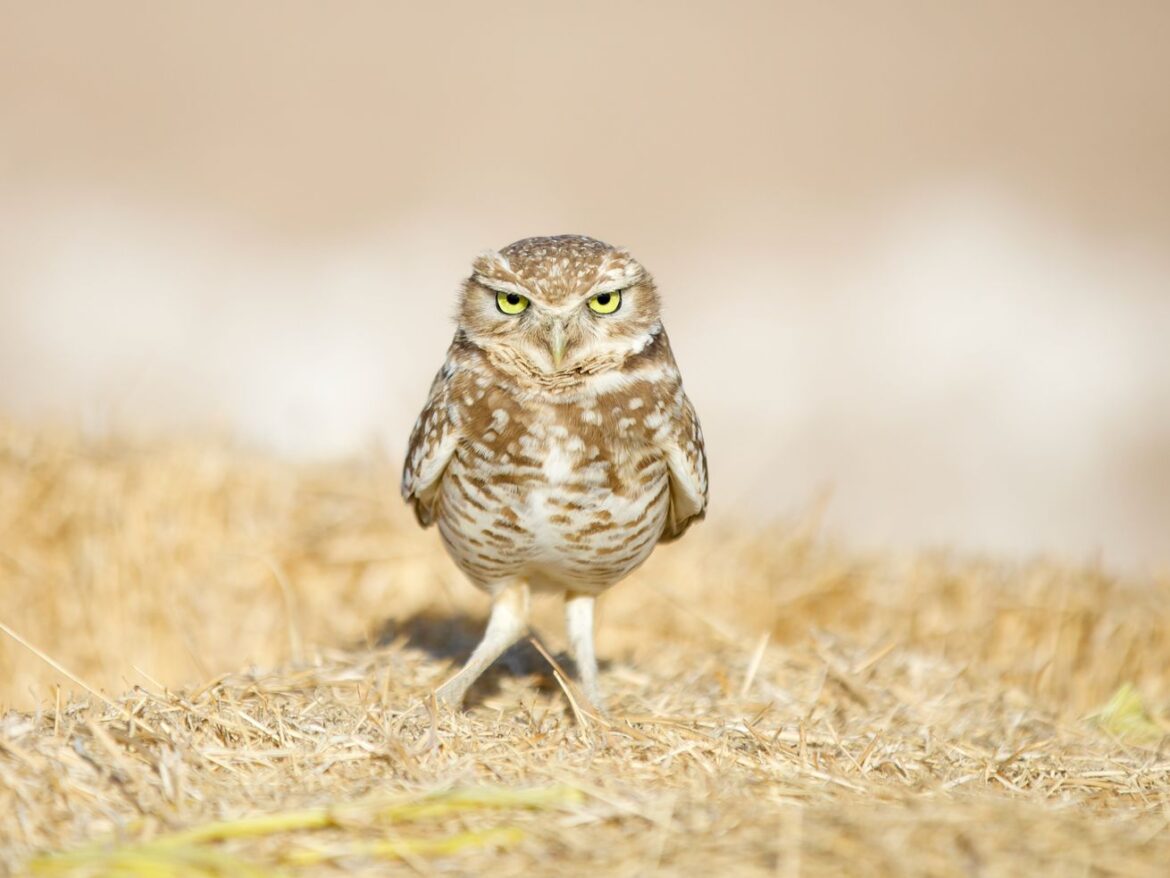Plot twist: Humans have accidentally helped save some animals, for once.
In the last decade, I’ve spent hundreds of hours hiking through forests and wetlands, across prairies and mountains, often looking for wildlife. In all that time, I’ve seen just two owls I can remember — a barred owl in an Iowa woodland and a great horned owl in New York City’s Central Park.
Even experienced birders have a hard time spotting these iconic avian predators. Owls have superb camouflage, often appearing identical to tree bark or a bank of fresh snow. Many of them are nocturnal, hunting for mice and frogs by moonlight. And they fly noiselessly, seldom flapping a pair of wings that has built-in silencers.
I am not an experienced birder, or even a regular one (I only saw the owl in Central Park because a friend pointed it out to me). Yet during a short week last month, I saw dozens of owls. I had no binoculars and no scope, but it didn’t matter. They were everywhere.
In March, I was in Southern California for a story about the Imperial Valley, a farming region wedged between the Salton Sea and the Mexico border. I was there to talk with farmers about the shrinking Colorado River; it waters their crops, including nearly all of the veggies Americans eat between November and March. But the local fauna caught my attention, too. On the ground near almost every farm I visited, I saw small, brown birds called burrowing owls.
Few owl varieties are more adorable than the burrowing owl. They are tiny, no larger than a child’s shoe; they can look a bit mean, like a cartoon villain; and they live like rodents in underground burrows, laying eggs many feet under the dirt.
/cdn.vox-cdn.com/uploads/chorus_asset/file/24575266/B88A0373.jpeg)
I was surprised to see so many of them here. Burrowing owls are a threatened species, declining across much of North America, and the Imperial Valley is one of the most ecologically transformed parts of the country. Neat rows of lettuce, carrots, and alfalfa have replaced the native desert habitat. Researchers have long known that, globally, farming is considered one of the greatest drivers (if not the greatest driver) of wildlife declines.
Yet as I drove around the valley, little owl heads ducked into burrows. I’d catch the flash of their bright yellow eyes while touring farms. The owls appear to be thriving.
/cdn.vox-cdn.com/uploads/chorus_asset/file/24575165/B88A0320_copy.jpeg)
What allows owls to flourish here, in a highly developed landscape, while human activities elsewhere put them and so many other threatened species at risk?
Questions like this are important as environmental advocates seek to stem the ongoing biodiversity crisis. Roughly 1 million animal and plant species are threatened with extinction worldwide and more than half of US birds are in decline. Perhaps, I thought, these owls could teach us that conserving nature isn’t just about protecting humanless habitats — remote jungles and national parks — but looking for ways to sustain the ecosystems where we live and work.
The burrowing owl was once widespread in the Western Hemisphere, abundant in deserts and other open areas from southwestern Canada and the American West down to the southernmost reaches of South America. But as human developments gobbled up more and more land, the birds began to vanish.
/cdn.vox-cdn.com/uploads/chorus_asset/file/24577010/a_canal_just_outside_of_calexico_copy.jpeg)
/cdn.vox-cdn.com/uploads/chorus_asset/file/24586003/vessey_romaine_lettuce_copy.jpg)
/cdn.vox-cdn.com/uploads/chorus_asset/file/24586034/sprinkler_s_on_vessey_s_cabbage_farm__2__copy__1_.jpeg)
/cdn.vox-cdn.com/uploads/chorus_asset/file/24576996/sheep_on_pasture_in_brawley_copy.jpg)
The survival of burrowing owls essentially depends on two things: burrows and food.
They don’t dig into the ground themselves but instead occupy tunnels dug by ground squirrels, prairie dogs, or other critters. The owls move in once the burrow is vacant or by forcefully evicting its resident (by eating it).
When it comes to food, these raptors aren’t picky. They’ll eat insects, rodents, lizards, and small(er) birds. Sometimes the owls will scatter feces around their burrows in order to attract and ultimately consume dung beetles.
/cdn.vox-cdn.com/uploads/chorus_asset/file/24575118/Owl1_forstory.jpeg)
In recent decades, though, owls have had a hard time fulfilling those needs.
Ranchers, farmers, and other landowners often kill burrowing rodents that eat crops and dig up the ground, creating a shortage of suitable holes. Growing cities and suburbs have paved over much of their habitat. Meanwhile, the US, Canada, and other countries have waged a war on crop-eating insects like grasshoppers, leaving the owls (and countless other animals) with less food.
Populations of burrowing owls have plummeted across much of their range. In the last 50 years, they’ve declined “dramatically” in Canada, where they’re now federally endangered, according to one 2018 study. US populations have fallen as well, according to the North American Breeding Bird Survey, though not as precipitously.
“They’ve declined in most of their native areas,” said Courtney Conway, an avian ecologist at the University of Idaho.
Owls in eastern Washington state and parts of coastal and central California have been especially hard hit, Conway said. In California, they’re dubbed a “species of special concern,” a vague category for species that are not officially endangered but still at risk.
Then there’s the Imperial Valley, which is in some ways an exception to this trend. While there were always burrowing owls in the valley, Conway said, they only occurred in low densities before humans developed the region, when it was an open desert. The growth of farmland caused their population to balloon.
It almost never rains in the Imperial Valley. Crops only grow here because of the Colorado River, an iconic feature of the American West that lies 60 miles east along the Arizona border. A large channel known as the All American Canal carries water to the valley, which then enters a series of smaller channels that run alongside farms.
Those farmside channels are key to the region’s burrowing owl abundance.
/cdn.vox-cdn.com/uploads/chorus_asset/file/24575179/B88A0334_copy.jpeg)
The banks are made of relatively loose dirt, which makes them easy for animals to burrow into. I saw holes everywhere while driving along the channels last month — and some of the resident excavators. Most of the burrows are dug by round-tailed ground squirrels, rodents about the size of a chipmunk. (As I drew near them, the rodents would chirp rather adorably and dart underground.)
Dirt banks along channels and roads make for great squirrel burrows, and those burrows make perfect nesting grounds for owls, Conway said.
/cdn.vox-cdn.com/uploads/chorus_asset/file/24577619/B88A0241_copy.jpeg)
The other secret to this owl oasis is food. The Colorado River fills the Imperial Valley with water, allowing farmers to grow crops, such as produce and forage grasses, year-round. That provides a steady source of sustenance for ground squirrels but also for a range of other critters that burrowing owls eat, such as beetles. “The animal life there is very rich because we’re putting huge amounts of water onto a desert,” Conway said, adding that agriculture has been “a boon to burrowing owls.”
Population data for burrowing owls is a bit spotty, but the region does appear to be a stronghold for the species, according to Conway and the Imperial Irrigation District (IID), a regional water and electric utility that monitors the birds. The Imperial Valley has one of the highest concentrations of burrowing owls anywhere in North America, Conway said.
Surveys commissioned by IID every few years from 2007 to 2020 indicate that there are somewhere between 7,000 and 11,000 owls along IID-operated channels — and the bird population is stable. These numbers are most certainly underestimates for the Imperial Valley because they don’t cover habitat across the entire region. “It’s a healthy population,” said Stevie Sharp, an environmental specialist at IID.
Farmers I spoke to in the Imperial Valley don’t have particularly strong feelings toward burrowing owls. They mostly let them be. And while growers do trap and kill some ground squirrels, eradication efforts haven’t been severe.
Perhaps that’s another reason why these owls are so abundant here: Farmers tolerate them.
(A complicated, 20-year-old water agreement between districts in Southern California also requires the IID to conserve the owls, such as by avoiding construction during certain times of the year.)
/cdn.vox-cdn.com/uploads/chorus_asset/file/24577903/B88A0371_copy__1_.jpeg)
The owls certainly benefit farmers, too, by preying on pests that might otherwise eat their crops, Conway said. It’s a good example of how maintaining at least some semblance of an ecosystem has value. Plants provide food for ground squirrels which provide homes for owls which provide free pest control.
The future of the region’s owl population is uncertain, and some data from the Breeding Bird Survey suggests it may be smaller than it was 25 years ago. Some experts also fear that any changes to farmland could cause declines, said Peter Bloom, a zoologist who was involved in some of the IID-commissioned surveys. If farmers are pushed to use less water as the Colorado River’s shortage worsens, for example, some of them may stop growing alfalfa. Hays tend to attract the insects that owls like to eat, he said.
/cdn.vox-cdn.com/uploads/chorus_asset/file/24575133/B88A0220_copy.jpeg)
But it’s clear that farmland has tremendously benefited them. And this point is worth emphasizing: While human activities often unravel ecosystems and the life they sustain, sometimes they form new ones that support important and even threatened species. This is especially true when farmers are paid to invest in projects that help restore some native ecosystem features.
All kinds of wild animals can flourish in human-dominated landscapes. A large and healthy population of river otters is living among farmland in Iowa, for example, which is perhaps the most ecologically disturbed state in the country. Even tiny patches of grass near airports can sustain important species.
This isn’t an attempt to glorify human development. Farms and cities are a big part of the problem; they’re why burrowing owls are rare in other parts of the continent. Rather, it’s an important reminder that wild animals can live alongside us if they can meet their basic needs and we let them be. Ultimately, there’s only so much land that we can envelop in parks and reserves, so we should conserve wildlife wherever we find it.



